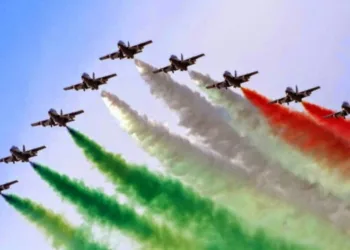The festive season in India is seeing the revival of the economic momentum that was lost to the shock waves delivered by the pandemic across sectors
BY VISHAL DUGGAL
As Indian communities living abroad are experiencing festive ambience all around after pandemic-stricken years, back home consumer sentiment is quite upbeat. The long festive season in India, which includes festivals such as Raksha Bandhan, Janmashtami, Ganesh Chaturthi, Onam, Navaratri, Durga Puja, Dussehra, Diwali, Bhai Dooj, Govardhan Puja, Chhath Puja and Christmas and ends with the New Year, is markedly different this time as it has revived the spirit of community celebrations and collective camaraderie.
After the dark shadows of Covid-19 have receded, global inflationary pressures and rising interest rates do pose challenges. But the Indian economy is showing resilience and the festive mood has boosted private consumption, besides buoying the pent-up consumer demand across the board. According to the recent state of the economy report of the Reserve Bank of India, robust central government capital outlays are supporting investment activity, backed by improvement in supply conditions, a good monsoon, strong momentum in manufacturing and a rebound in services. India is a festival-driven country, known for its vibrant traditions and festivals spanning centuries. Consumers are loosening their purse-strings during the ongoing festival season which may turn out to be one of the best in a long time. According to a survey by Local Circles, festive spending in 2022 is likely to touch $32 billion, higher than 2020 and 2021 and a little short of the $37 billion spent in 2019.
Further, as per the findings of the “Global State of the Consumer Tracker” by consulting firm Deloitte, Indian consumers are likely to buy more discretionary products, spend more on recreation and entertainment, restaurants, and leisure travel within the next six months. Consumer spending will see a spike across age groups in all categories despite inflationary concerns. “As on August 2022, 78 per cent Indian consumers surveyed across age groups plan on buying a vehicle in the next six months, of which 84 per cent plan to buy a new one,” the report said.
Similarly, according to a survey conducted by digital EMI/ checkout finance platform ZestMoney, over 50 percent of respondents plan to spend between ₹50,000 to ₹1 lakh in the coming months. The survey, covering over 7,300 consumers, revealed that six out of every 10 respondents plan to splurge during the festival season. A majority of the surveyed consumers indicated that they were looking for maximum value; about 60 percent of them expressed preference for credit options such as EMIs for festive shopping, while 40 percent were in favour of using their savings to shop for their chosen goods.

According to another survey by Axis My India, 20 percent of people will shop more during the2022 festive season as compared to 2021. Overall, in the wake of improved consumer sentiment across key sub-indices like essential and discretionary products and increased mobility, 48 percent of consumers will shop more during the festive season as compared to the rest of the year. Improvement in mobility sentiments highlights the fact that more and more people are enjoying the stores and malls experience of discovering, shopping and gifting, says the survey. This is the first time since 2020 that brick-and-mortar or offline retail players will be able to run business on a big scale.
While on-ground and physical buying trends have accelerated, e-commerce players too are not lagging behind in cashing in on the festive season, with Amazon and Flipkart, which command over 60 percent of the e-commerce market in India, running long-duration mega festival sales. Other online retailers too have lined up attractive offers and incentives across FMCG, fashion apparel, consumer electronics, mobile phones, large appliances, automobiles, home décor, furnishings, food, beverages, fitness, gardening equipment, kitchen accessories, costume jewellery, personal care and other categories. And shoppers are willing to increase their spends this time in a sort of ‘revenge shopping’ post-pandemic.
Significantly, industry experts anticipate a growth of 20-25 percent in gross merchandise value (GMV) or the total value of sales on e-commerce platforms for the second half of the 2022 calendar year. While H2 2021 saw a GMV of close to $8 billion across e-commerce platforms, H2 2022 is estimated to clock between $11 billion and $12 billion in online sales.
Consequently, brands and sellers on e-commerce platforms have ramped up their logistics and warehousing operations as 60-75 percent of their annual business comes from sales made during the festive season. They have tied up with sellers from local shops, traditional artisans, weavers, and innovative startups to serve customers across India. This is because the demand for consumer goods is on the rise in India from Tier II and III cities and towns as well. Notably, rural demand is a new key factor in driving retail sales
in the country.
According to a consumer survey titled “Festive Economy and Online Retail for MSMEs in India”, conducted by CUTS Institute for Regulation and Competition (CIRC), a not-for-profit research and capacity building organisation, 42 percent of online players experienced moderate to exponential growth in sales with 71 percent reporting a significant increase in sales during the festive season.
It is significant that e-commerce giants create new employment opportunities in the informal sector, and boost small and medium-sized businesses (SMBs) in complementary industries. It was the e-commerce segment that provided the much-needed resilience to keep SMBs afloat during the pandemic years. In the post-pandemic scenario, rapid digital transformation is providing local MSMEs with access to larger clientele, helping them strengthen their operations and sales.
Brands invariably spend big on advertising to catch eyeballs during the festive season which accounts for more than 30-35 percent of their revenue. Understandably, the news and entertainment media industry too is benefitting from the buoyant festive outlook. Big-ticket sporting events such as the T20 World Cup and the FIFA World Cup have added more spark to the festive season. Television and digital, apart from print and OOH, are the preferred platforms for advertisers looking at maximising the opportunity to engage with customers across geographies and age groups.
Overall, the festive season is driving consumer spending, which bodes well on the country’s economic front, despite global challenges.








